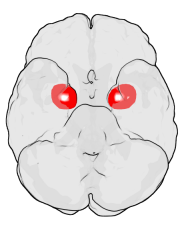 Image via WikipediaFollowing up on yesterday's discussion in the Mindfulness and Psychotherapy Study Group, I'm posting two papers on brain activity and mindfulness. Stein (2008) and Creswell (2008) both report that the habit of mindfulness leads to greater prefrontal cortical activity, and less amygdala activation, during the processing of emotions. This is just the finding that we (and especially TS) predicted. Congratulations, Tom!
Image via WikipediaFollowing up on yesterday's discussion in the Mindfulness and Psychotherapy Study Group, I'm posting two papers on brain activity and mindfulness. Stein (2008) and Creswell (2008) both report that the habit of mindfulness leads to greater prefrontal cortical activity, and less amygdala activation, during the processing of emotions. This is just the finding that we (and especially TS) predicted. Congratulations, Tom!
Thus, when asked to identify the emotion expressed in the photo of a person's face, people high in mindfulness approached the task with less emotional reactivity than people who were low in mindfulness. When we think of the typical mindfulness procedure of being aware of and noting mental states without getting caught up in them, this finding makes a lot of sense.
It also underscores another point from our discussion. Mindfulness is not simply sensory awareness, but a complete and integrated awareness in which our verbal, emotional, and sensory brains all participate. Mindfulness relies on what Marsha Linehan called our "wise mind" (aka prefrontal cortex) along with all of our other faculties. Maybe we could say that mindfulness does not involve stopping thinking (as people sometimes believe) but rather integrating our thinking without getting caught up in it. These studies clearly point to a rebalancing of complex brain functions that occurs as the result of mindfulness. Mindfulness is not (as my Zen teacher would say) "lobotomy zen." It's more like bringing our whole selves to bear as we experience our lives. It's a way of being all one piece.


![Reblog this post [with Zemanta]](http://img.zemanta.com/reblog_e.png?x-id=43a1c6bb-f88c-4e3e-ab44-5a7639cd943f)



1 comment:
From my experience the "wise mind" way of thinking also applies to improving institutional organization and leadership skills. Very interesting.
Post a Comment